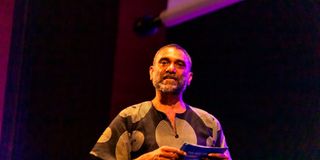When trauma is passed down generations

Human rights activist Kumi Naidoo during the Wellbeing Summit for Social Change in Bilbao, Spain in June.
What you need to know:
- Naidoo's mother’s death accelerated his involvement in the liberation struggle, and a year after the death of his mother, Naidoo was expelled from school.
- In 2017, Naidoo was head-hunted by Amnesty International for the role of Secretary General. On his interview day, he learnt that his sister Kay had been diagnosed with brain cancer. She passed away 34 days later at the age of 56.
During this year’s Wellbeing Summit for Social Change in Bilbao, Spain which Healthy Nation team attended, a number of mental health topics were discussed but what struck many attendees was intergenerational trauma.
In what became a curious but disheartening explanation, South African human rights activist Kumi Naidoo, 57, who started off as a child activist fighting apartheid in the 1970s and 1980s, detailed his own personal account of the trauma.
“I experienced my first trauma at seven when I lost my brother. My mother took her own life at the age of 38, part of the reason being failure to get any support for the loss of her son and problems in her marriage. I was 15 then and my eldest sister Kay was 19,” Naidoo narrated.
His mother’s death accelerated his involvement in the liberation struggle, and a year after the death of his mother, Naidoo was expelled from school. In 2017, Naidoo was head-hunted by Amnesty International for the role of Secretary General. On his interview day, he learnt that his sister Kay had been diagnosed with brain cancer. She passed away 34 days later at the age of 56.
“I was completely broken at the loss of my sister but the fact that I had not dealt with my mother’s suicide resulted in the scab around her death being broken, and it felt like I had lost my mum and my sister altogether,” the activist said.
Naidoo remembers that when his mother died, he would take sedatives and strong sleeping tablets. Before the death of his sister, Amnesty International had already announced his appointment.
“The possibility that I should have paused and said I could not take on such a heavy burden after such a massive loss did not occur to me,” he added. When he took over at Amnesty, the organisation was going through immense trauma due to a senior colleague taking his own life in their office. Two weeks later, a young intern committed suicide.
“Given that my mother’s suicide was now resurrected as a result of my sister’s death, instead of seeing this as a moment of pause, I saw it as an okay moment. I figured I knew about suicide and could help Amnesty come out of this,” Naidoo said.
The most painful thing at work for Naidoo was working with the two families of his departed colleagues to help them heal from the horrific loss they had suffered.
“People seemed to have judged that I had done well in this responsibility. Some even saying that my personal suicide history had helped me deal with maximum empathy and sensitivity,” he said.
A few months into the job, he visited Iraq and Syria. In Raqqa, Syria, he went to where volunteers were carefully exhuming bodies at a mass grave. “I was completely devastated, but I was leading a full-person delegation in one of the most unsafe places in the world; I had to be strong,” says Naidoo.
Soon the pressure of dealing with the trauma of the suicides within Amnesty, his sister’s death, the resurrection of his mother’s suicide, and the massive responsibility he had taken at Amnesty meant that he was working 20 hours, and he was in a perpetual sleep deficit.
This took a toll on him and his hypertension rose. Medication failed to control it, and eventually, friends back home said he was being irresponsible. “You’re going to have stroke; you’ll be dead in months at the way you are carrying on. The responsible thing for you to do is to stop, recalibrate your life, deal with the trauma you have not dealt with; then maybe you can contribute for another decade or so,” they told him.
Naidoo would eventually resign from Amnesty International. He then started the process of healing from all the trauma he encountered in his life.
The most important part of his healing was writing a letter to his mother, telling her what happened in his childhood years since she passed on. “Writing the letter was painful; for the first time I cried for my mother’s loss every time I sat down to write during the lockdown,” he said. On the morning of February 23 this year, tragedy hit home again, and Naidoo’s son Rikhado (South African Rapper Riky Rick) committed suicide. “None of what was troubling him was private; everything was in the public domain. It was about the needless loss of life he was seeing around him in our own country, the corruption, the inequality, the concerns around the environment, and running out of time on climate change.”
The gentle and caring manner in which Louisa, his wife, broke the news added to Naidoo’s desperate sense of guilt.
“I can safely say that I would not have survived the death of Rikhado if it was not for the internal work I did since my resignation from Amnesty International,” he concluded in his speech.
To address trauma passed down through generations, Dr Margaret Kagwe, a psychologist, says it is necessary to educate the public about trauma, especially among professionals in the human service industry such as teachers, health workers, and law enforcers so that they can help identify persons who may be suffering and in need of help.
Emotional unavailability, trouble regulating mood and emotions, difficulties in forming relationships, maintaining healthy relationships, self-isolation, withdrawal, sleep disturbances, low self-esteem, anxiety, substance use, and suicidal thoughts are signs that people suffering from the trauma exhibit.
“People with this kind of trauma need a safe environment where they are not re-traumatised; Psychotherapy is also helpful in allowing those affected to tell their stories in a safe environment, where they are taught skills to manage their symptoms,” she says According to Dr Kagwe, cognitive restructuring is also useful in helping people make sense of their traumatic memories.
She further explains that “the signs of intergenerational trauma may not be easy to identify since they resemble signs of other mental health conditions”. However, history taken from a psychological evaluation can help identify patterns that indicate intergenerational trauma.





